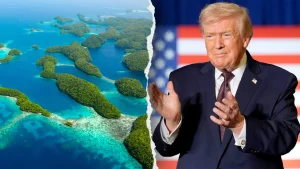Florida’s Iconic Reef Builders: The Tragic Decline of Elkhorn and Staghorn Coral
In a devastating blow to Florida’s marine ecosystem, scientists have confirmed what many coral reef experts have feared for years: elkhorn and staghorn coral species have crossed the threshold into functional extinction throughout Florida waters. These once-abundant branching corals, which historically built and shaped the state’s vibrant reef systems, now exist in such diminished numbers that they no longer fulfill their critical ecological role. The dramatic decline represents not just the loss of iconic marine species, but a fundamental restructuring of underwater ecosystems that have thrived for thousands of years along Florida’s coastline.
The Silent Collapse of Florida’s Reef Architects
For decades, elkhorn coral (Acropora palmata) and staghorn coral (Acropora cervicornis) served as the primary reef-building species throughout the Florida Reef Tract, the third-largest barrier reef system in the world. These fast-growing, branching corals created complex three-dimensional habitats that supported tremendous biodiversity and provided essential shoreline protection. “These species were the architects of Florida’s reefs,” explains Dr. Valerie Chamberland, coral restoration specialist at the Florida Marine Science Institute. “They grew in dense thickets that formed the backbone of the entire reef ecosystem, creating homes for countless fish species and buffering our coastlines from storm surges.” Historical photographs from just the 1970s show vast fields of these corals stretching across shallow reefs, creating underwater forests that teemed with marine life. Today, those same locations reveal barren, algae-covered rubble fields with only isolated coral colonies struggling to survive.
The scientific declaration of functional extinction carries specific ecological meaning beyond mere rarity. While small populations of both coral species still exist in Florida waters, researchers have determined they no longer fulfill their ecosystem engineering roles. Dr. Margaret Miller, research director at the Coral Restoration Foundation, elaborates: “Functional extinction means these species no longer contribute meaningfully to reef growth, habitat creation, or reproductive success at an ecosystem scale. Individual colonies exist, but they’re too scattered and disconnected to maintain genetic diversity or rebuild reef structure.” This ecological collapse happened with startling speed – within a single human generation, these corals declined by more than 97% throughout the Caribbean basin, with Florida’s populations among the most severely impacted.
Multiple Threats Converge on Fragile Ecosystems
The path to functional extinction for these iconic corals reflects the complex, interconnected challenges facing marine ecosystems worldwide. Rather than a single catastrophic event, researchers point to a perfect storm of environmental stressors. “We’ve documented at least five major factors driving this decline,” states Dr. James Porter, professor emeritus of marine ecology at the University of Florida. “First came disease outbreaks in the 1980s that decimated Acropora populations throughout the Caribbean. Then excessive coastal development increased sedimentation and pollution. Overfishing removed key herbivores that kept algae in check. More recently, climate change has driven increasingly frequent and severe coral bleaching events, while ocean acidification weakens coral skeletons.” The 2014-2015 global bleaching event delivered a particularly devastating blow to Florida’s remaining Acropora colonies, with water temperatures exceeding coral tolerance thresholds for weeks.
The timing of these multiple stressors proved especially catastrophic. Before populations could recover from one impact, another would strike, preventing the natural resilience that might have saved these species. Dr. Esther Rivera, NOAA coral monitoring coordinator, explains this cumulative effect: “Healthy coral populations can potentially recover from isolated disturbances – a hurricane, a disease outbreak, even a bleaching event. But Florida’s elkhorn and staghorn faced these challenges simultaneously and repeatedly, with no recovery window between events. The frequency and intensity of disturbances simply outpaced their natural recovery abilities.” The corals’ reproductive biology compounds these challenges. As colonies became increasingly isolated, successful sexual reproduction declined dramatically, limiting genetic diversity and adaptive capacity. Although both species can reproduce through fragmentation—where broken branches establish new colonies—this asexual reproduction doesn’t introduce new genetic combinations that might help populations adapt to changing conditions.
Ecosystem-Wide Consequences Ripple Through Florida’s Waters
The functional extinction of these foundational species triggers far-reaching consequences throughout Florida’s marine ecosystems. “These weren’t just two species among many on the reef,” emphasizes Dr. Robert Brumbaugh, marine ecologist with The Nature Conservancy. “They were keystone species that created habitat complexity essential for hundreds of other marine organisms.” Studies indicate that reefs dominated by elkhorn and staghorn coral supported significantly higher fish biodiversity and biomass compared to areas dominated by other coral species. The three-dimensional structure they created provided nursery habitat for commercially and recreationally important fish species, including grouper, snapper, and lobster. Their rapid growth rates—up to 10-15 centimeters per year—allowed them to keep pace with sea-level rise and maintain reef structure after storm damage.
The economic implications of this ecological transformation extend far beyond the water. Florida’s reef-related tourism generates approximately $8.5 billion annually and supports over 70,000 jobs in the state. Healthy coral reefs provide critical shoreline protection, reducing wave energy during storms by up to 97% and preventing millions in property damage each year. “The loss of these structure-building corals makes our coastlines more vulnerable to erosion and storm surge,” warns Dr. Catherine Cooper, coastal geologist at the University of Miami. “It’s not just about losing beautiful underwater scenery—it’s about losing natural infrastructure that protects human communities.” Indigenous knowledge further highlights what’s being lost. For generations, coastal tribes including the Calusa and Tequesta utilized these reefs for sustainable fishing practices, incorporating their seasonal cycles into cultural traditions that persisted for centuries before European contact.
Restoration Efforts Offer Glimmers of Hope Amid Crisis
Despite the grim assessment of functional extinction, unprecedented restoration efforts across Florida provide reason for cautious optimism. “We refuse to accept extinction as inevitable,” declares Tania Romero, director of the Florida Keys Coral Restoration Alliance. “What we’ve lost naturally, we’re determined to rebuild through science-based intervention.” Innovative restoration techniques have evolved dramatically over the past decade. Coral nurseries—underwater farms where coral fragments grow on specialized structures—now operate throughout the Florida Keys and beyond. These nurseries successfully grow thousands of elkhorn and staghorn coral fragments each year. When fragments reach suitable size, restoration teams strategically outplant them to degraded reef areas, carefully considering genetic diversity, site selection, and ecological factors to maximize survival.
Advanced genetic research complements these physical restoration efforts. Scientists at the University of Miami’s Rosenstiel School have identified coral genotypes with enhanced resilience to thermal stress, disease resistance, and growth rates. By propagating these resilient genotypes, restoration programs aim to establish populations better adapted to changing ocean conditions. Simultaneously, land-based conservation measures target water quality improvements and enhanced coastal management. “Restoration isn’t just about growing corals—it’s about creating the conditions where they can thrive naturally again,” explains Dr. Michael Crosby, president of Mote Marine Laboratory. “This means addressing everything from wastewater management to fishing practices to climate change.” While acknowledging the immense scale of the challenge, restoration practitioners point to promising initial results, with some outplanted sites showing colony survival rates exceeding 80% and successful sexual reproduction events documented at restoration sites. The coordinated, multi-agency Florida Reef Tract Rescue Project represents the largest coral conservation effort ever attempted, demonstrating unprecedented collaboration across government agencies, research institutions, and conservation organizations.
The Path Forward: What Florida’s Coral Crisis Teaches Us
The functional extinction of Florida’s elkhorn and staghorn corals serves as both ecological tragedy and urgent call to action. “What’s happening to these corals is a preview of what awaits many marine ecosystems if current trends continue,” warns Dr. Joanna Walczak, Southeast Regional Administrator for Florida’s Department of Environmental Protection. “But it also demonstrates how quickly we can lose species that have thrived for millions of years.” The crisis underscores the critical need for holistic approaches to marine conservation that address multiple stressors simultaneously. Meaningful progress requires coordinated action at local, national, and global scales—from improving water quality and fisheries management locally to addressing climate change internationally.
The story of Florida’s corals contains important lessons about ecosystem resilience and tipping points. “These species survived for millennia through hurricanes, temperature fluctuations, and natural disturbances,” notes Dr. Sylvia Earle, legendary oceanographer and National Geographic Explorer-in-Residence. “What they couldn’t withstand was the combined and intensified pressures we’ve introduced in just the last few decades.” Public engagement represents another crucial component of coral conservation. Recent surveys indicate growing awareness of coral reef decline among Florida residents, with 68% expressing willingness to support stronger water quality regulations and marine protected areas. Educational initiatives from Key Largo to Jacksonville introduce thousands of students annually to coral ecology through classroom programs and field experiences. While the functional extinction declaration marks a somber milestone in Florida’s environmental history, it also galvanizes unprecedented conservation commitment. The question remains whether these combined efforts can reverse the decline before ecological changes become truly irreversible. “We’re in a race against time,” Dr. Earle concludes, “but I’ve witnessed remarkable recoveries when we give nature the chance. These corals have survived for millions of years—with our help, they might survive millions more.”










